Environmental Life-Cycle Assessment and Life-Cycle Cost Analysis of a High-Rise Mass Timber Building: A Case Study in Pacific Northwestern United States
Abstract
:1. Introduction
2. Case Study
3. Methodology
3.1. Goal, Scope and Functional Unit
3.2. System Boundary and Life Cycle Stage
3.2.1. Product and Construction Stage (Module A)
3.2.2. Operation Stage (Module B)
3.2.3. End of Life Stage (Module C)
3.2.4. System Expansion (Module D)
3.2.5. Carbon Sequestration and Storage
3.3. Life Cycle Impact Assessment
3.4. Life Cycle Costing
4. Results
5. Discussion
5.1. Operational Energy Consumption
5.2. Cross Laminated Timber
5.3. End of Life Management and Carbon Analysis
6. Conclusions
Author Contributions
Funding
Institutional Review Board Statement
Informed Consent Statement
Data Availability Statement
Conflicts of Interest
References
- Buildings a Source of Enormous Untapped Efficiency Potential. Available online: https://www.iea.org/topics/buildings (accessed on 16 May 2021).
- Amiri, A.; Ottelin, J.; Sorvari, J.; Junnila, S. Cities as carbon sinks-classification of wooden buildings. Environ. Res. Lett. 2020, 15, 094076. [Google Scholar] [CrossRef]
- Himes, A.; Busby, G. Wood buildings as a climate solution. Dev. Built Environ. 2020, 4, 100030. [Google Scholar] [CrossRef]
- Schneider-Marin, P.; Lang, W. Environmental costs of buildings: Monetary valuation of ecological indicators for the building industry. Int. J. Life Cycle Assess. 2020, 25, 1637–1659. [Google Scholar] [CrossRef]
- Anderson, R.; Atkins, D.; Beck, B.; Dawson, E.; Gale, C.B. 2020 State of the Industry: North American Mass Timber. 2020, p. 156. Available online: http://www.lfpdc.lsu.edu/publications/bits/2020/20200609-2020%20North-American-Mass-Timber-State-of-the-industry-report-is-available-for-free%20.pdf (accessed on 16 May 2021).
- D’Amico, B.; Pomponi, F.; Hart, J. Global potential for material substitution in building construction: The case of cross laminated timber. J. Clean. Prod. 2021, 279, 123487. [Google Scholar] [CrossRef]
- Harte, A.M. Mass timber—The emergence of a modern construction material. J. Struct. Integr. Maint. 2017, 2, 121–132. [Google Scholar] [CrossRef]
- Zhou, J.; Chui, Y.H.; Gong, M.; Hu, L. Elastic properties of full-size mass timber panels: Characterization using modal testing and comparison with model predictions. Compos. Part B Eng. 2017, 112, 203–212. [Google Scholar] [CrossRef]
- Kremer, P.D.; Symmons, M.A. Mass timber construction as an alternative to concrete and steel in the Australia building industry: A PESTEL evaluation of the potential. Int. Wood Prod. J. 2015, 6, 138–147. [Google Scholar] [CrossRef]
- Pierobon, F.; Huang, M.; Simonen, K.; Ganguly, I. Environmental benefits of using hybrid CLT structure in midrise non-residential construction: An LCA based comparative case study in the US PNW. J. Build Eng. 2019, 26, 100862. [Google Scholar] [CrossRef]
- Mass Timber Market Analysis (Completed for: Council of Western State Foresters). Available online: https://www.oregon.gov/ODF/Documents/ForestBenefits/Beck-mass-timber-market-analysis-report.pdf (accessed on 16 May 2021).
- Van de Lindt, J.W.; Furley, J.; Amini, M.O.; Pei, S.; Tamagnone, G.; Barbosa, A.R.; Rammer, D.; Line, P.; Fragiacomo, M.; Popovski, M. Experimental seismic behavior of a two-story CLT platform building. Eng. Struct. 2019, 183, 408–422. [Google Scholar] [CrossRef]
- Cross-Laminated Timber in the 2015 IBC and NDS (MAT242). Available online: https://www.awc.org/pdf/education/mat/AWC-MAT242-CLT-2015NDS-2hr-150825.pdf (accessed on 16 May 2021).
- Tall Wood Buildings and the 2021 IBC: Up to 18 Stories of Mass Timber. Available online: https://www.awc.org/pdf/education/des/AWC-DES607A-TallWood2021IBC-190619-color.pdf (accessed on 16 May 2021).
- Fiscal Monitor, October 2019: How to Mitigate Climate Change. Available online: https://www.imf.org/en/Publications/FM/Issues/2019/10/16/Fiscal-Monitor-October-2019-How-to-Mitigate-Climate-Change-47027 (accessed on 16 May 2021).
- Building Trends: Mass Timber. Available online: https://www.woodworks.org/publications-media/building-trends-mass-timber/ (accessed on 16 May 2021).
- Scouse, A.; Kelley, S.S.; Liang, S.; Bergman, R. Regional and net economic impacts of high-rise mass timber construction in Oregon. Sustain. Cities Soc. 2020, 61, 102154. [Google Scholar] [CrossRef]
- Gu, H.; Liang, S.; Bergman, R. Comparison of building construction and life-cycle cost for a high-rise mass timber building with its concrete alternative. For. Prod. J. 2020, 70, 482–492. [Google Scholar]
- Liang, S.; Gu, H.; Bergman, R.; Kelley, S. Comparative life-cycle assessment of a mass timber building and concrete alternative. Wood Fiber Sci. 2020, 52, 217–229. [Google Scholar] [CrossRef]
- Zelinka, S.L.; Williamson, T.; Martinson, K.L.; Ritter, M.A. Research needs assessment for the mass timber industry: Proceedings of the 2nd North American mass timber research needs workshop. In General Technical Report FPL-GTR-273; Department of Agriculture, Forest Service, Forest Products Laboratory: Madison, WI, USA, 2019; pp. 1–41. [Google Scholar]
- Santos, R.; Costa, A.A.; Silvestre, J.D.; Vandenbergh, T.; Pyl, L. BIM-based life cycle assessment and life cycle costing of an office building in Western Europe. Build. Environ. 2020, 169, 106568. [Google Scholar] [CrossRef]
- EN 15978. 2011 Sustainability of construction works—Assessment of environmental performance of buildings—Calculation method. In European Committee for Standardization; CEN European Committee for Standardization, Management Centre: Brussels, Belgium, 2011; pp. 1–60. [Google Scholar]
- Ortiz, O.; Castells, F.; Sonnemann, G. Sustainability in the construction industry: A review of recent developments based on LCA. Constr. Build. Mater. 2009, 23, 28–39. [Google Scholar] [CrossRef]
- Durlinger, B.; Crossin, E.; Wong, J. Life Cycle Assessment of a Cross Laminated Timber Building; Forest & Wood Products Australia Limited: Melbourne, Australia, 2013; pp. 1–110. [Google Scholar]
- Jayalath, A.; Naravatnam, S.; Ngo, T.; Mendis, P.; Hewson, N.; Aye, L. Life cycle performance of cross Laminated Timber mid-rise residential buildings in Australia. Energy Build. 2020, 223, 110091. [Google Scholar] [CrossRef]
- CLT Buildings: A WBLCA Case Study Series—Five Whole Building Life Cycle Assessment Case Studies. Available online: http://tallwoodinstitute.org/sites/twi/files/Case_Studies_Final_2.pdf (accessed on 16 May 2021).
- Liu, Y.; Guo, H.; Sun, C.; Chang, W.S. Assessing Cross Laminated Timber (CLT) as an alternative material for mid-rise residential buildings in cold regions in China—A life-cycle assessment approach. Sustainability 2016, 8, 1047. [Google Scholar] [CrossRef] [Green Version]
- Gu, H.; Bergman, R. Life cycle assessment and environmental building declaration for the design building at the University of Massachusetts. In General Technical Report FPL-GTR-255; U.S. Department of Agriculture, Forest Service, Forest Products Laboratory: Madison, WI, USA, 2018; pp. 1–71. [Google Scholar]
- Chen, Z.; Gu, H.; Bergman, R.; Liang, S. Comparative Life cycle assessment of a high-rise mass timber building with an equivalent reinforced concrete alternative using the Athena Impact Estimator for Buildings. Sustainability 2020, 12, 4708. [Google Scholar] [CrossRef]
- Churkina, G.; Organschi, A.; Reyer, C.P.O.; Ruff, A.; Vinke, K.; Liu, Z.; Reck, B.K.; Graedel, T.E.; Schellnhuber, H.J. Buildings as a global carbon sink. Nat. Sustain. 2020, 3, 269–276. [Google Scholar] [CrossRef]
- ASTM E917-17. Standard Practice for Measuring Life-Cycle Costs of Buildings and Building Systems; ASTM International: West Conshohocken, PA, USA, 2017. [Google Scholar]
- Liang, S.; Gu, H.; Bilek, T.; Bergman, R. Life-cycle cost analysis of a mass-timber building: Methodology and hypothetical case study. In Research Paper FPL-RP-702; U.S. Department of Agriculture, Forest Service, Forest Products Laboratory: Madison, WI, USA, 2019; pp. 1–11. [Google Scholar]
- Dara, C.; Hachem-Vermette, C.; Assefa, G. Life cycle assessment and life cycle costing of container-based single-family housing in Canada: A case study. Build. Environ. 2019, 163, 106332. [Google Scholar] [CrossRef]
- Lu, H.R.; Hanandeh, A.E.; Gilbert, B.P. A comparative life cycle study of alternative materials for Australian multi-storey apartment building frame constructions: Environmental and economic perspective. J. Clean. Prod. 2017, 166, 458–473. [Google Scholar] [CrossRef]
- Teshnizi, Z.; Pilon, A.; Storey, S.; Lopez, D.; Froese, T.M. Lessons Learned from Life Cycle Assessment and Life Cycle Costing of Two Residential Towers at the University of British Columbia. Procedia CIRP 2018, 69, 172–177. [Google Scholar] [CrossRef]
- Potential for Tall Wood Buildings to Sequester Carbon, Support Forest Communities, and Create New Options for Forest Management. Available online: https://www.fpl.fs.fed.us/documnts/rips/fplrip-4851-018-NCSU-TallBldgs-Bergman-Kelley.pdf (accessed on 16 May 2021).
- Bowick, M. Wood Innovation and Design Centre Prince George, BC: An Environmental Building Declaration According to EN 15978 Standard; Athena Sustainable Materials Institute: Ottawa, ON, Canada, 2015; pp. 1–55. [Google Scholar]
- Chen, C.X.; Pierobon, F.; Ganguly, I. Life cycle assessment (LCA) of cross-laminated timber (CLT) produced in western Washington: The role of logistics and wood species mix. Sustainability 2019, 11, 1278. [Google Scholar] [CrossRef] [Green Version]
- RSMeans Online. Available online: https://www.rsmeansonline.com/ (accessed on 2 February 2019).
- Puettmann, M.; Milota, M. Life-Cycle Assessment for Wood-Fired Boilers Used in the Wood Products Industry. For. Prod. J. 2017, 67, 381–389. [Google Scholar] [CrossRef]
- Tabakaev, R.; Shanenkov, I.; Kazakov, A.; Zavorin, A. Thermal processing of biomass into high-calorific solid composite fuel. J. Anal. Appl. Pyrolysis 2017, 124, 94–102. [Google Scholar] [CrossRef]
- Michaels, J.A.; Skog, K.E. The decomposition of forest products in landfills. Int. Biodeterior. Biodegrad. 1997, 39, 145–158. [Google Scholar]
- Skog, K.E. Sequestration of carbon in harvested wood products for the United States. For. Prod. J. 2008, 58, 56–72. [Google Scholar]
- Documentation for Greenhouse Gas Emission and Energy Factors Used in the Waste Reduction Model (WARM). Available online: https://www.epa.gov/sites/production/files/2019-10/documents/warm_v15_management_practices_updated_10-08-2019.pdf (accessed on 16 May 2021).
- Bowick, M. Athena Brock Commons Tallwood House, University of British Columbia: An Environmental Building Declaration According to EN 15978 Standard; Athena Sustainable Materials Institute: Ottawa, ON, Canada, 2018; pp. 1–55. [Google Scholar]
- Grann, B. A Comparative Life Cycle Assessment of Two Multistory Residential Buildings: Cross-Laminated Timber vs. Concrete Slab and Column with Light Gauge Steel Walls; FPInnovations: Pointe-Claire, QC, Canada, 2013; p. 142. [Google Scholar]
- ISO 14040. Environmental Management—Life Cycle Assessment—Principles and Framework; International Organization for Standardization: Geneva, Switzerland, 2006. [Google Scholar]
- ISO 14044. Environmental Management—Life Cycle Assessment—Requirement and Guidelines; International Organization for Standardization: Geneva, Switzerland, 2006. [Google Scholar]
- ISO 21930. Sustainability in buildings and civil engineering works. In Core Rules for Environmental Product Declarations of Construction Products and Services; International Organization for Standardization: Geneva, Switzerland, 2006. [Google Scholar]
- Bare, J. TRACI 2.0: The tool for the reduction and assessment of chemical and other environmental impacts 2.0. Clean Technol. Environ. Policy 2011, 13, 687–696. [Google Scholar] [CrossRef]
- Cover, J. Mass timber: The new sustainable choice for tall buildings. Int. J. High-Rise Build. 2020, 9, 87–93. [Google Scholar]
- Thigpen, A. Sustainable Value Creation through Mass Timber Development in North America. Master’s Thesis, Massachusetts Institute of Technology, Cambridge, MA, USA, 2020. [Google Scholar]
- Energy Efficiency. Available online: https://www.woodworks.org/why-wood/energy-efficiency/ (accessed on 16 May 2021).
- Khavari, A.M.; Pei, S.; Tabares-Velasco, P.C. Energy consumption analysis of multistory cross-laminated timber residential buildings: A comparative study. J. Archit. Eng. 2016, 22, 04016002. [Google Scholar] [CrossRef]
- Kneifel, J. Life-cycle carbon and cost analysis of energy efficiency measures in new commercial buildings. Energy Build. 2010, 42, 333–340. [Google Scholar] [CrossRef]
- Marszal, A.J.; Heiselberg, P.; Bourrelle, J.S.; Musall, E.; Voss, K.; Sartori, I.; Napolitano, A. Zero Energy Building—A review of definitions and calculation methodologies. Energy Build. 2011, 43, 971–979. [Google Scholar] [CrossRef]
- Huang, M.; Chen, C.X.; Pierobon, F.; Ganguly, I.; Simonen, K. Life Cycle Assessment of Katerra’s Cross-Laminated Limber (CLT) and Catalyst Building: Final Report; University of Washington: Seattle, WA, USA, 2019; pp. 1–63. [Google Scholar]
- Puettmann, M.; Sinha, A.; Ganguly, I. CORRIM REPORT—Life Cycle Assessment of Cross Laminated Timbers Produced in Oregon; Consortium for Research on Renewable Industrial Materials: Corvallis, OR, USA, 2018; pp. 1–36. [Google Scholar]
- Brandt, K.; Wilson, A.; Bender, D.; Dolan, J.D.; Wolcott, M.P. Techno-economic analysis for manufacturing cross-laminated timber. BioResources 2019, 14, 7790–7804. [Google Scholar] [CrossRef]
- Delem, L.; Wastiels, L. Module D in the Building Life Cycle: Significance Based on a Case Study Analysis. IOP Conf. Ser. Earth Environ. Sci. 2019, 290, 012042. [Google Scholar] [CrossRef]
- Rammer, D.R.; de Melo Moura, J.; Ross, R.J. Structural performance of the second oldest glued-laminated structure in the United States. In Proceedings of the Structures Congress; American Society of Civil Engineers: Boston, MA, USA, 2014; pp. 1233–1243. [Google Scholar]
- Teder, M.; Wang, X. Nondestructive evaluation of a 75-year old glulam arch. In Proceedings of the 18th International Nondestructive Testing and Evaluation of Wood Symposium; Southern Research Station US Forest Service: Madison, WI, USA, 2013; pp. 624–632. [Google Scholar]
- Gunn, J.S.; Ganz, D.J.; Keeton, W.S. Biogenic vs. geologic carbon emissions and forest biomass energy production. GCB Bioenergy 2012, 4, 239–242. [Google Scholar] [CrossRef]
- Bergman, R.D. The Effect on Climate Change Impacts for Building Products When Including the Timing of Greenhouse Gas Emissions. Ph.D. Thesis, University of Wisconsin, Madison, WI, USA, 2012. [Google Scholar]
- Salazar, J.; Bergman, R. Temporal Considerations of Carbon Sequestration in LCA. In Proceedings from the LCA XIII International Conference; American Center for Life Cycle Assessment: Orlando, FL, USA, 2013; pp. 136–142. [Google Scholar]
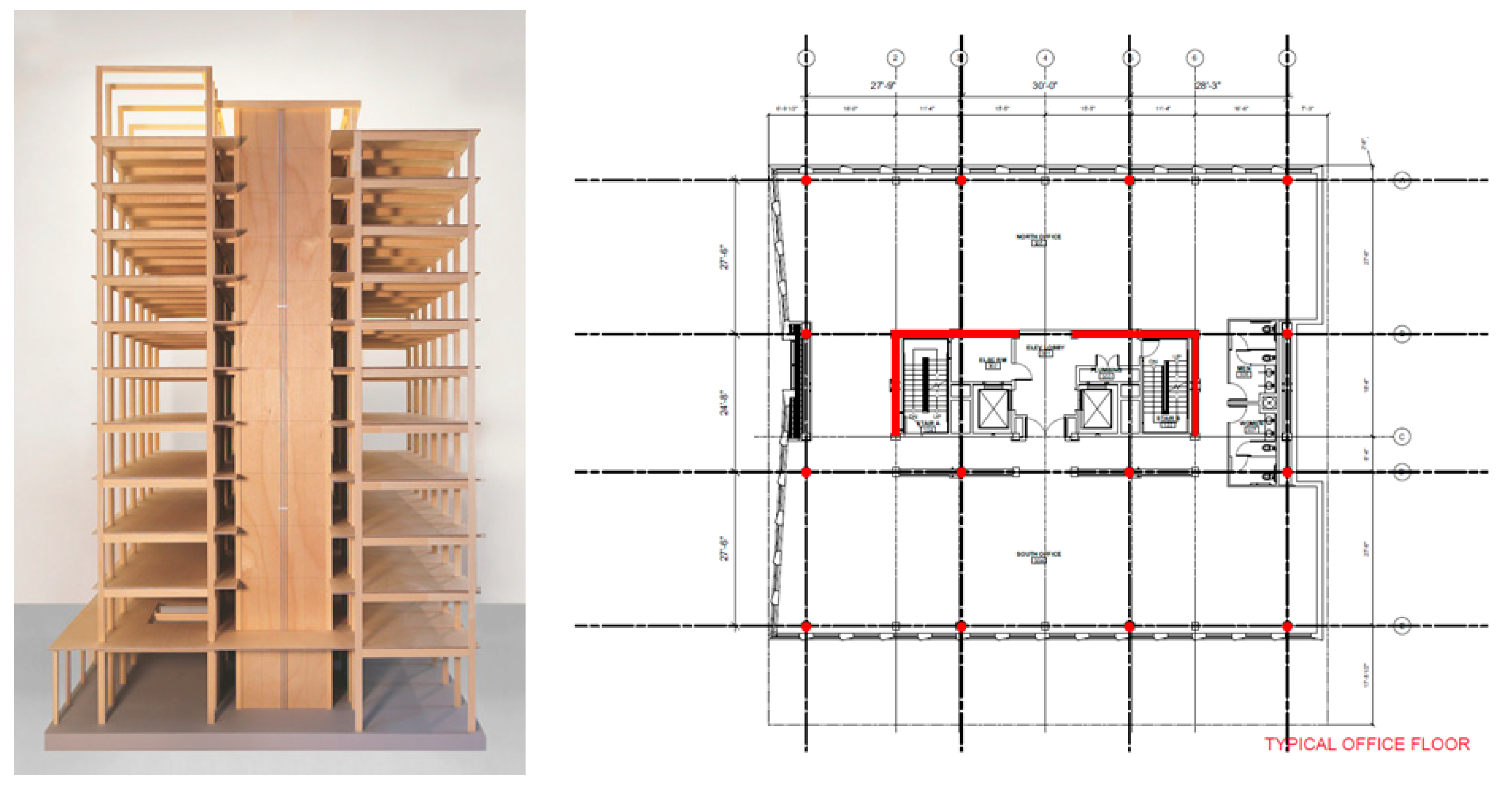

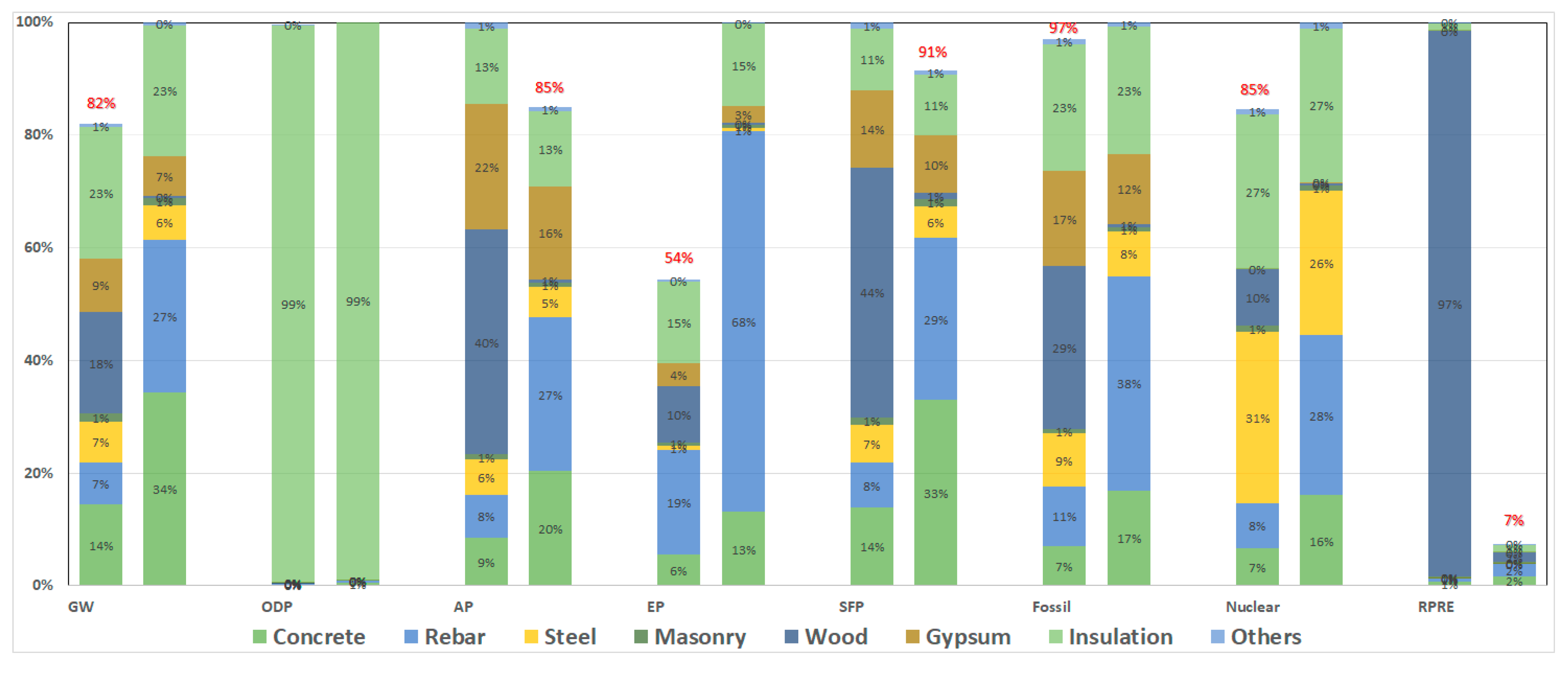
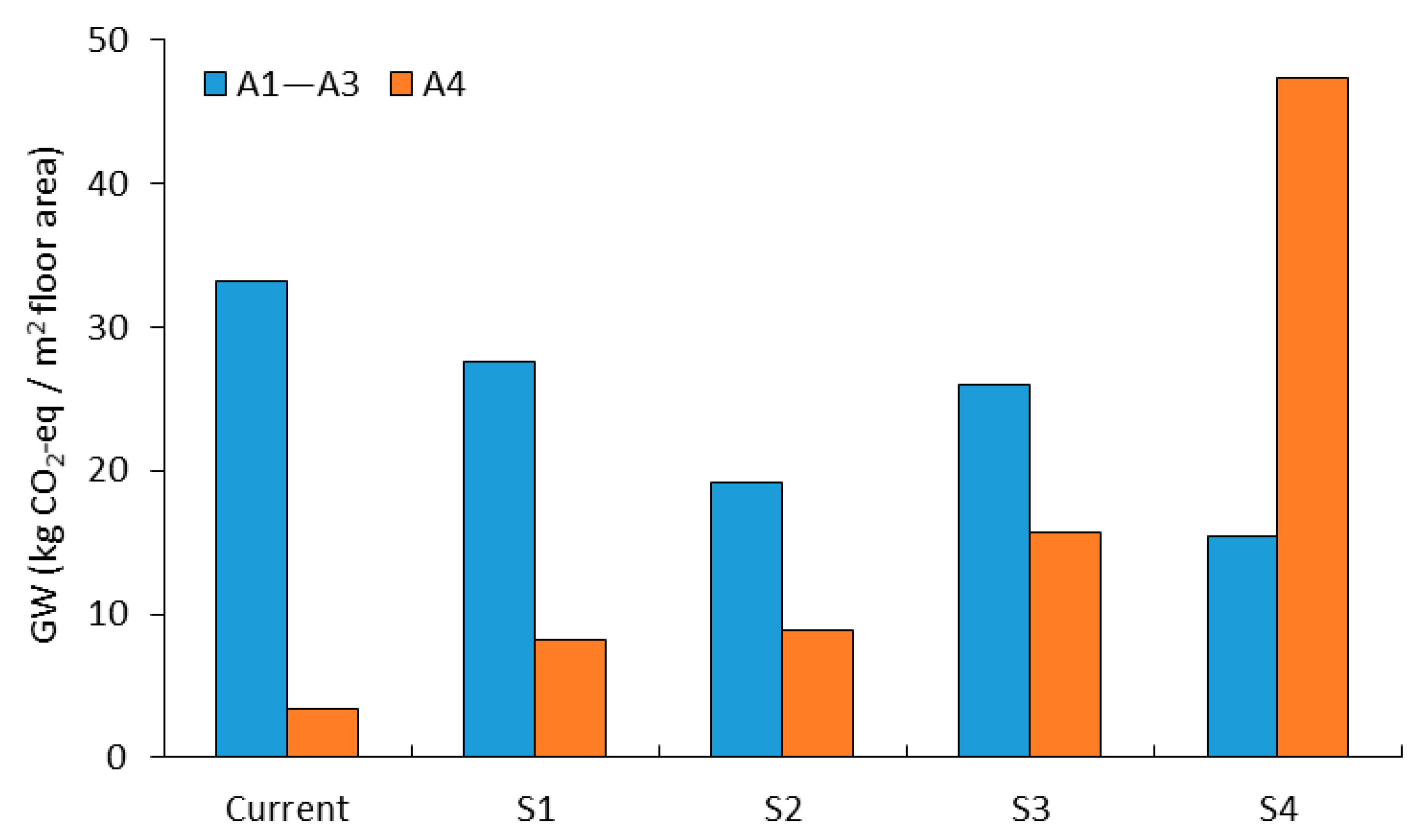
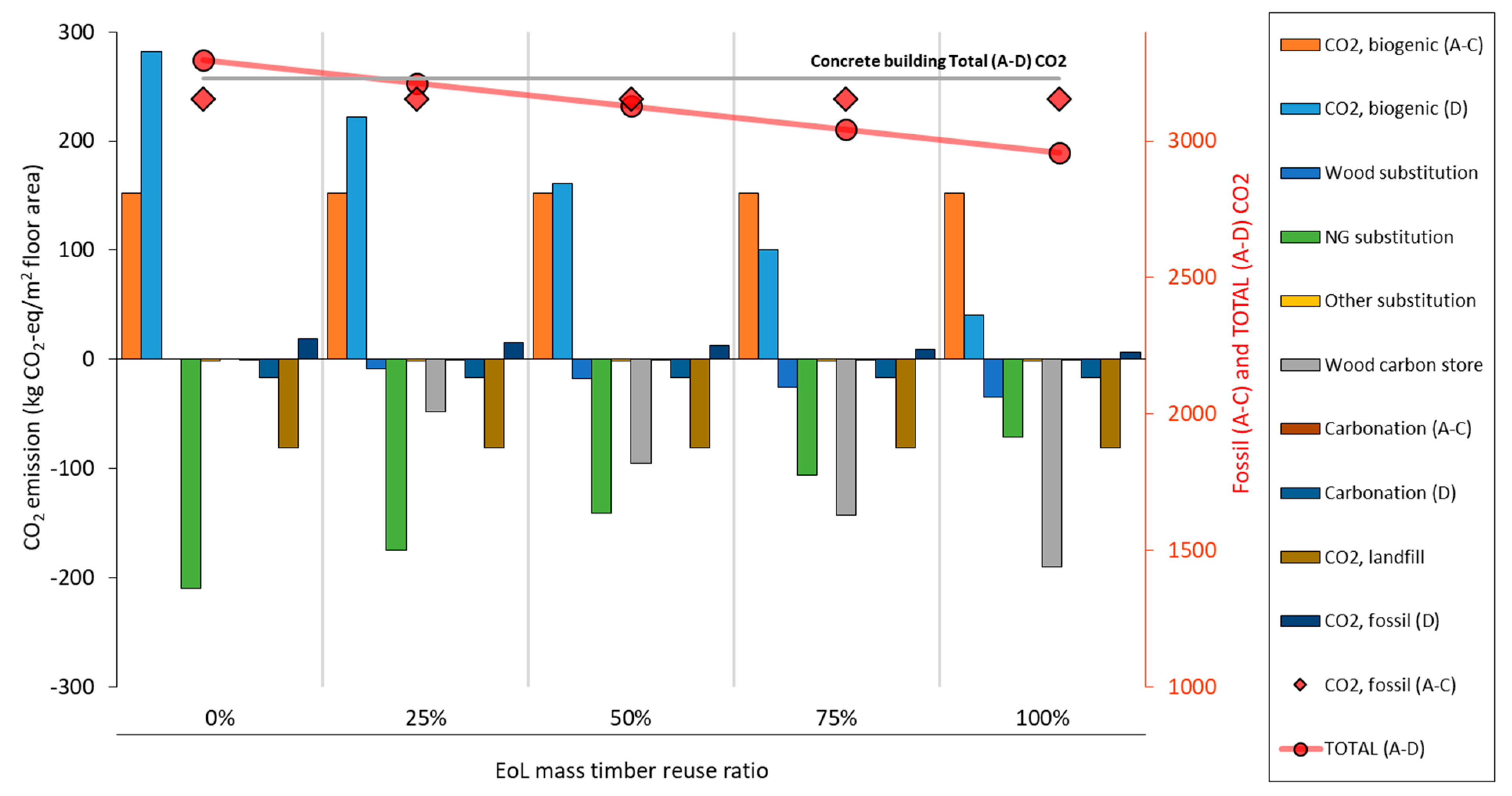
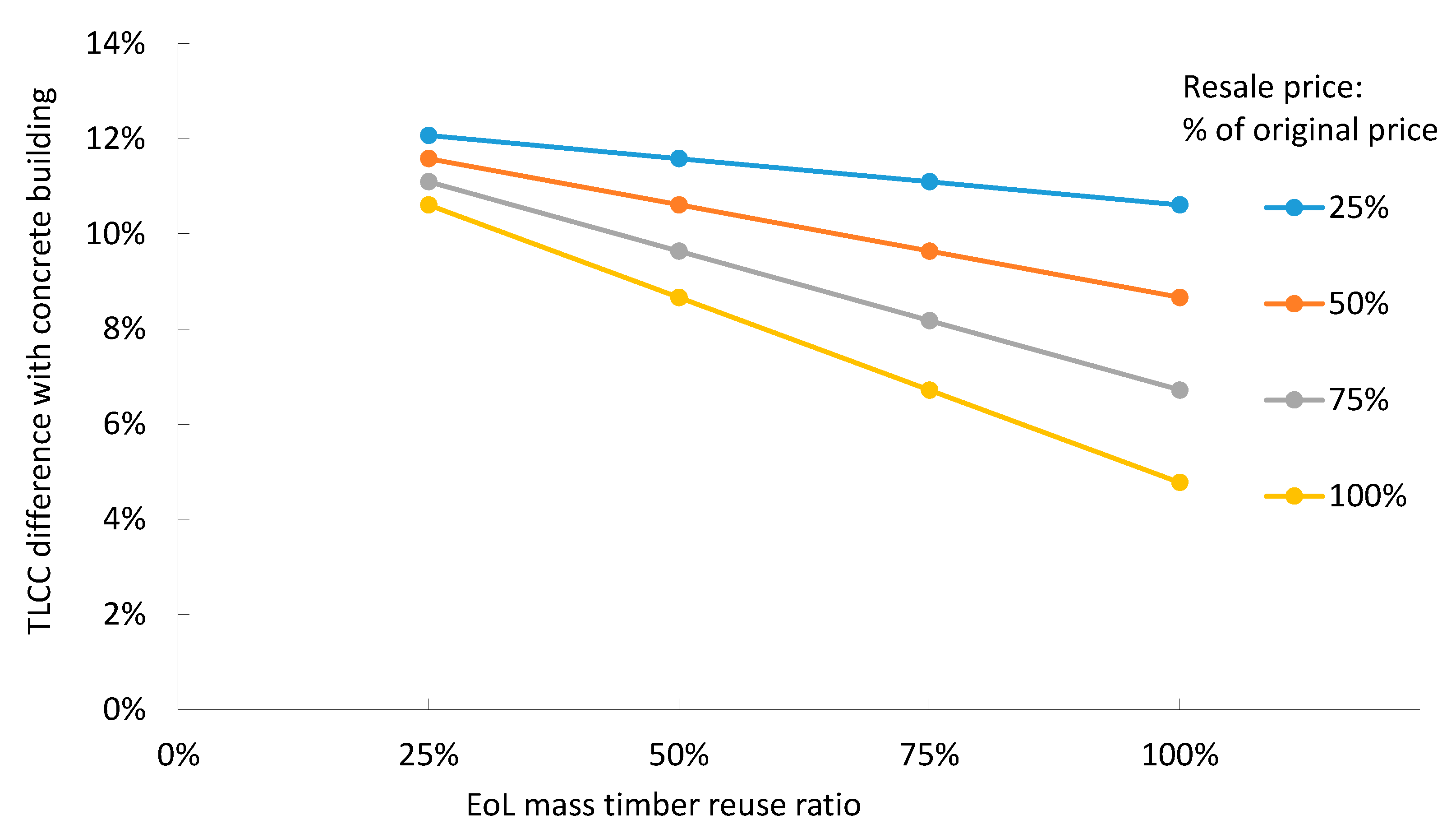
| Materials | Unit | Buildings | Transport Distance (km) | Maintenance and Repair | Landfill Rate 2 | ||
|---|---|---|---|---|---|---|---|
| Mass Timber | Concrete | Frequency (year) | Material Use 1 (%) | ||||
| 1″ Mineral wool | m2 | 286 | 286 | 172 | 20 | 100 | 1.00 |
| 1″ Polystyrene board | m2 | 11,773 | 11,774 | 1299 | 20 | 100 | 1.00 |
| 1/2″ Gypsum board, regular | m2 | 4154 | 3337 | 172 | 20 | 2 | 1.00 |
| 3/8″ Plywood | m2 | 3889 | 3889 | 320 | 20 | 2 | 0.60 |
| 5/8″ Gypsum board, fire-resistant | m2 | 72,237 | 53,042 | 172 | 20 | 2 | 1.00 |
| 60 mil TPO membrane | m2 | 352 | 352 | 172 | 1 | 2 | 1.00 |
| Acrylic latex paint | L | 12,196 | 6691 | 642 | 10 | 1 | 1.00 |
| Acrylic adhesive | L | 117 | 117 | 840 | 10 | 1 | 1.00 |
| Aluminum | kg | 31,039 | 31,051 | 663 | 12 | 12 | 0.02 |
| CLT | m3 | 1782 | - | 320 | - | - | 0.30 |
| Coated steel deck | kg | 106 | 106 | 431 | 1 | 3 | 0.02 |
| Concrete | m3 | 1104 | 2627 | 24 | 15 | 2 | 0.45 |
| Concrete masonry unit | kg | 71,031 | 70,908 | 24 | 15 | 2 | 0.45 |
| Glulam | m3 | 557 | - | 320 | - | - | 0.30 |
| Hollow structural steel | kg | 87,324 | 77,071 | 431 | - | - | 0.02 |
| Mortar | kg | 94,851 | 94,561 | 172 | 15 | 2 | 0.45 |
| Rebar | kg | 103,845 | 376,272 | 431 | 15 | 2 | 0.30 |
| Silicone sealant | L | 578 | 578 | 840 | 10 | 1 | 1.00 |
| Steel sheet | kg | 10,716 | 7391 | 431 | 1 | 3 | 0.02 |
| Steel welded wire mesh | kg | 105 | 105 | 431 | 15 | 2 | 0.30 |
| Utility | Usage | Cost ($) |
|---|---|---|
| Electricity (kWh) | 738,128 | 62,372 |
| Natural gas (m3) | 9397 | 2947 |
| Water (m3) | 8518 | 84,495 |
| Category | Unit | A1–3 | A4 | A5 | B2–4 | B6–7 | C 1 | D | A–C | % Diff. | A–D | % Diff. |
|---|---|---|---|---|---|---|---|---|---|---|---|---|
| GW | kg CO2 eq | 177 | 8.53 | 6.75 | 52.0 | 2898 | 10.3 | −364 | 3153 | −1.57 | 2789 | −11.6 |
| ODP | kg CFC−11 eq | 1.9E−4 | 1.5E−8 | 1.3E−8 | 5.6E−4 | 2.1E−4 | 1.1E−6 | −7.9E−7 | 9.6E−4 | −0.33 | 9.6E−4 | −0.38 |
| AP | kg SO2 eq | 0.89 | 0.05 | 0.09 | 0.12 | 6.83 | 3.05 | −0.15 | 11 | 8.89 | 11 | 7.63 |
| EP | kg N eq | 0.18 | 0.00 | 0.01 | 0.04 | 21.5 | 0.04 | −0.03 | 22 | −0.81 | 22 | −0.90 |
| SFP | kg O3 eq | 11.4 | 1.36 | 2.89 | 1.28 | 94.8 | 1.32 | −1.84 | 113 | −0.18 | 111 | −1.40 |
| Fossil | MJ | 2019 | 107 | 90.9 | 454 | 34,277 | 120 | −1820 | 37,068 | −0.34 | 35,248 | −5.08 |
| Nuclear | MJ | 196 | 1.56 | 1.33 | 62 | 6445 | 2.53 | −20.1 | 6707 | −0.71 | 6687 | −0.91 |
| Renewable | MJ | 955 | 0.24 | 0.21 | 9.22 | 8784 | 0.61 | −481 | 9749 | 10.1 | 9269 | 4.68 |
| Cost | USD ($) | A1–5: 2281 | 469 | 1257 | C-D: −30 | - | - | 3976 | 9.64 | |||
| Region | Main Wood Species | Lumber GW | Electricity GW |
|---|---|---|---|
| (kg CO2-eq/m3) | (kg CO2-eq/kWh) | ||
| Pacific Northwest | Douglas-fir and western hemlock | 57.8 | 0.51 |
| Northeast | Eastern spruce | 46.8 | 0.31 |
| Southeast | Southern pine | 81.4 | 0.77 |
| Total Cost of CLT Use | Value ($ Per m2 Floor Area) |
|---|---|
| 95% confidence interval | 354 ± 2.8 |
| Standard deviation | 45 |
| 97.5th percentile | 427 |
| Coefficient of variation | 13% |
Publisher’s Note: MDPI stays neutral with regard to jurisdictional claims in published maps and institutional affiliations. |
© 2021 by the authors. Licensee MDPI, Basel, Switzerland. This article is an open access article distributed under the terms and conditions of the Creative Commons Attribution (CC BY) license (https://creativecommons.org/licenses/by/4.0/).
Share and Cite
Liang, S.; Gu, H.; Bergman, R. Environmental Life-Cycle Assessment and Life-Cycle Cost Analysis of a High-Rise Mass Timber Building: A Case Study in Pacific Northwestern United States. Sustainability 2021, 13, 7831. https://doi.org/10.3390/su13147831
Liang S, Gu H, Bergman R. Environmental Life-Cycle Assessment and Life-Cycle Cost Analysis of a High-Rise Mass Timber Building: A Case Study in Pacific Northwestern United States. Sustainability. 2021; 13(14):7831. https://doi.org/10.3390/su13147831
Chicago/Turabian StyleLiang, Shaobo, Hongmei Gu, and Richard Bergman. 2021. "Environmental Life-Cycle Assessment and Life-Cycle Cost Analysis of a High-Rise Mass Timber Building: A Case Study in Pacific Northwestern United States" Sustainability 13, no. 14: 7831. https://doi.org/10.3390/su13147831
APA StyleLiang, S., Gu, H., & Bergman, R. (2021). Environmental Life-Cycle Assessment and Life-Cycle Cost Analysis of a High-Rise Mass Timber Building: A Case Study in Pacific Northwestern United States. Sustainability, 13(14), 7831. https://doi.org/10.3390/su13147831






